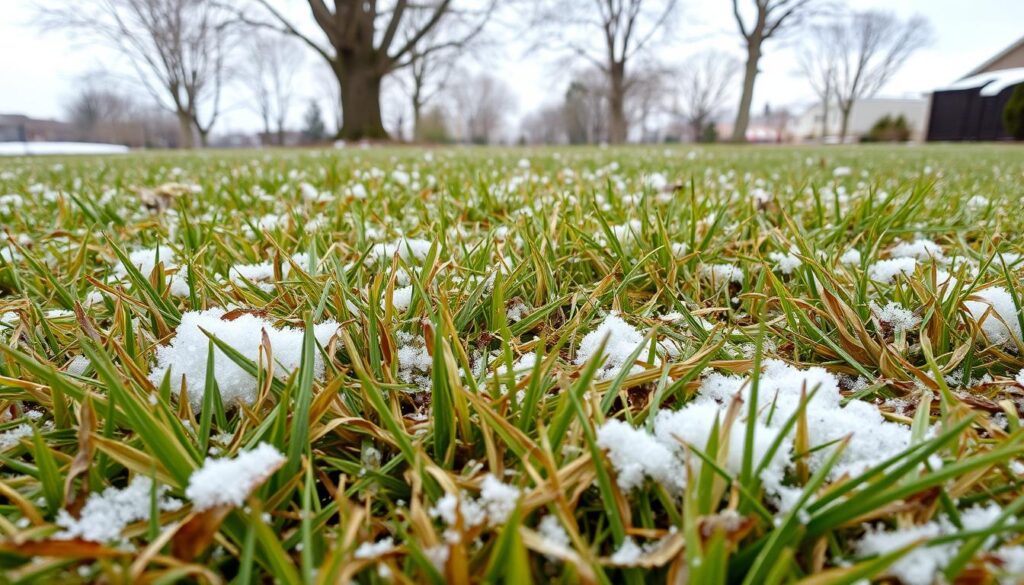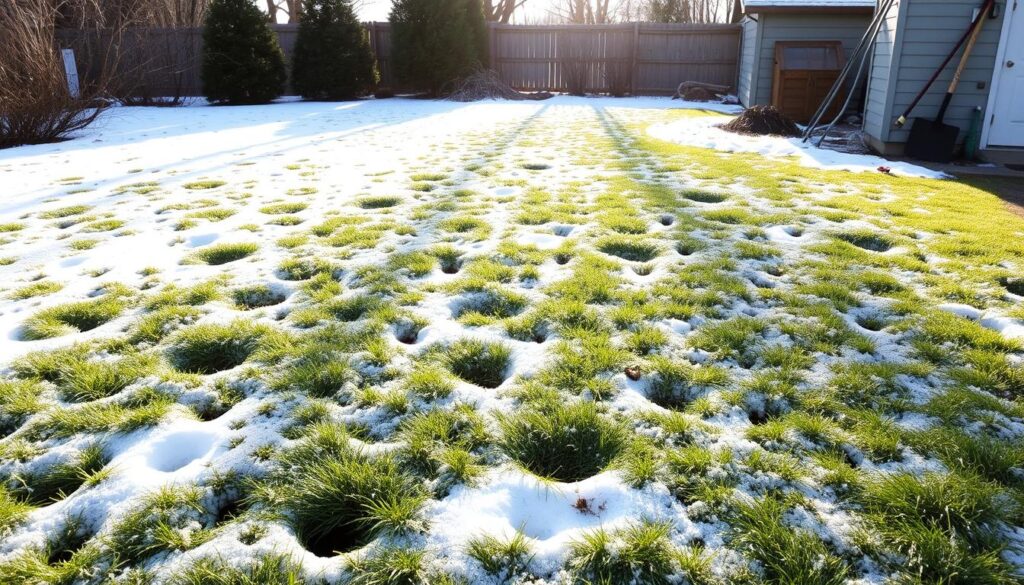As winter comes, homeowners face special challenges in lawn care. Protecting grass from harsh cold weather is crucial. This guide will cover five common issues that can harm your lawn in the cold months. It also offers tips for keeping your grass safe.
Knowing these problems is essential for good winter lawn care. We’ll talk about snow mold and frost damage, among others. Our advice will help you keep your lawn healthy and strong all winter.
Let’s explore winter lawn care and how to protect your grass from harsh weather. With the right knowledge and tools, your lawn can make it through winter and bloom in the spring.
Understanding Winter’s Impact on Your Lawn
Winter can be tough on your lawn. As temperatures drop, your grass faces challenges that can lead to cold weather grass damage. Let’s explore how winter conditions affect your lawn and what you can do to minimize winter lawn stress.
Cold Weather Effects on Grass Health
When temperatures plummet, grass goes dormant to conserve energy. This natural process helps protect the plant, but it doesn’t make it invincible. Extreme cold can still cause damage to grass blades and roots. Frost heave, which occurs when soil freezing pushes grass crowns out of the ground, is a common issue in harsh winters.

Snow and Ice Coverage
Snow can act as an insulator, protecting grass from severe cold. But it’s not all good news. Heavy snow can lead to snow mold, a fungal disease that thrives in cold, wet conditions. Ice, on the other hand, can suffocate grass by blocking air flow. When ice melts, it can leave behind areas of damaged turf.
Seasonal Soil Changes
Soil freezing is a major concern during winter. As water in the soil freezes, it expands, potentially damaging grass roots. This process can also lead to soil compaction, making it harder for roots to grow when spring arrives. Additionally, freeze-thaw cycles can cause soil to heave, disrupting root systems and creating an uneven lawn surface.
Understanding these winter lawn stressors is crucial for developing an effective care strategy. By taking preventive measures, you can help your lawn weather the winter and emerge strong in spring.
Winter Lawn Problems and Prevention Strategies
Winter can be tough on lawns. Cold weather, snow, and ice harm grass health. Let’s look at common winter lawn issues and how to protect your yard.
Snow Mold Development
Snow mold is a fungal disease that shows up when snow melts. It creates gray or pink patches on your lawn. To prevent snow mold, rake leaves before winter and avoid piling snow on grass areas.
Winter Kill Damage
Winter kill grass happens when extreme cold harms or kills grass plants. To prevent this, apply a winter fertilizer in late fall. This helps grass roots store nutrients for the cold months ahead.
Crown Hydration Issues
Crown hydration occurs when grass absorbs water during a winter thaw, then refreezes. This can rupture plant cells. For crown hydration protection, improve soil drainage and avoid walking on frozen grass.
Salt Damage from De-icing
Salt damage lawn is a common problem near roads and walkways. Salt draws moisture from grass, causing dehydration. To minimize salt damage:
- Use sand or kitty litter instead of salt when possible
- Shovel snow before it turns to ice
- Water areas near salted surfaces in early spring
By understanding these winter lawn problems, you can take steps to protect your grass. With proper care, your lawn will be ready to thrive when spring arrives.
Essential Winter Lawn Preparation Steps
Getting your lawn ready for winter is key to its health in spring. The right steps can shield your grass from harsh winter weather. This way, your lawn will be ready to grow lush when it’s warmer.
Fall Fertilization Techniques
Fall lawn fertilization is a must for winter prep. Use a slow-release fertilizer high in potassium to boost grass roots and cold resistance. Spread it over your lawn six weeks before the first frost for the best outcome.
Proper Mowing Height Adjustments
Changing your mowing height for winter is vital. Lower your mower blades to 2 to 2.5 inches, which is slightly shorter than in summer. This helps prevent snow mold and keeps pests away from tall grass in winter.
Soil Testing and pH Balance
Keeping your soil pH balanced is essential for grass health in winter. Test your soil and aim for a pH between 6.0 and 7.0. If it’s off, add lime to raise it or sulfur to lower it. A balanced pH ensures your grass can take in nutrients well, even when it’s cold.
- Test soil pH in early fall
- Apply amendments as needed
- Allow time for adjustments before winter
By following these steps, you’ll have a lawn that can handle winter’s challenges and bloom in spring.
Protecting Your Lawn During Winter Months
Keeping your lawn healthy all year is key. As it gets colder, your grass needs extra care. Here are some tips to help your lawn thrive in winter.
Proper snow removal is important. Too much snow can harm your grass. Here’s how to remove snow safely:
- Choose a plastic snow shovel to minimize damage to grass blades
- Avoid piling snow in one spot to prevent compaction
- Create pathways to distribute foot traffic evenly
It’s also crucial to reduce foot traffic on frozen grass. Frozen blades are fragile and can break easily. Use plywood boards to make walkways and protect your lawn.
“A well-protected lawn in winter leads to a lush, green yard in spring.”
Don’t forget to keep your grass hydrated in winter. It might seem odd, but your grass still needs water. Water it deeply before the ground freezes to keep roots moist.
By following these winter lawn care tips, you’ll keep your lawn healthy all year. A bit of extra work now will pay off when spring comes.
Spring Recovery for Winter-Damaged Lawns
As winter fades, it’s time to focus on spring lawn recovery. The first step is to assess any winter damage your grass might have suffered. Walk around your yard, looking for brown or bare patches that indicate areas needing attention.
Assessment of Winter Damage
Take note of discolored areas, which could be signs of snow mold or winter kill. These spots will need special care during your winter damage repair efforts. Check for compacted soil or salt damage near walkways and driveways, as these areas may require extra attention.
Repair and Restoration Methods
Once you’ve identified problem areas, it’s time to start the repair process. Rake away dead grass and debris to allow air and sunlight to reach the soil. Aerate compacted areas to improve drainage and root growth. Apply a thin layer of compost to boost soil health and promote new growth.
Reseeding Damaged Areas
Grass reseeding is crucial for filling in bare spots. Choose a grass seed mix that matches your existing lawn and is suitable for your climate. Spread the seeds evenly over the damaged areas, gently rake them into the soil, and keep the area moist until new growth appears. With these steps, your lawn will be on its way to lush, green recovery by summer.
Conclusion
Repairing your lawn after winter damage may seem daunting, but with the right approach and consistent care, you can restore it to its full, vibrant glory. By identifying problem areas, taking targeted steps to improve soil health, and reseeding damaged spots, your lawn will thrive as the warmer months approach. A healthy lawn not only enhances the beauty of your outdoor space but also provides a welcoming environment for relaxation and enjoyment. Start your lawn care efforts today, and you’ll reap the rewards of a lush, green lawn all season long.


